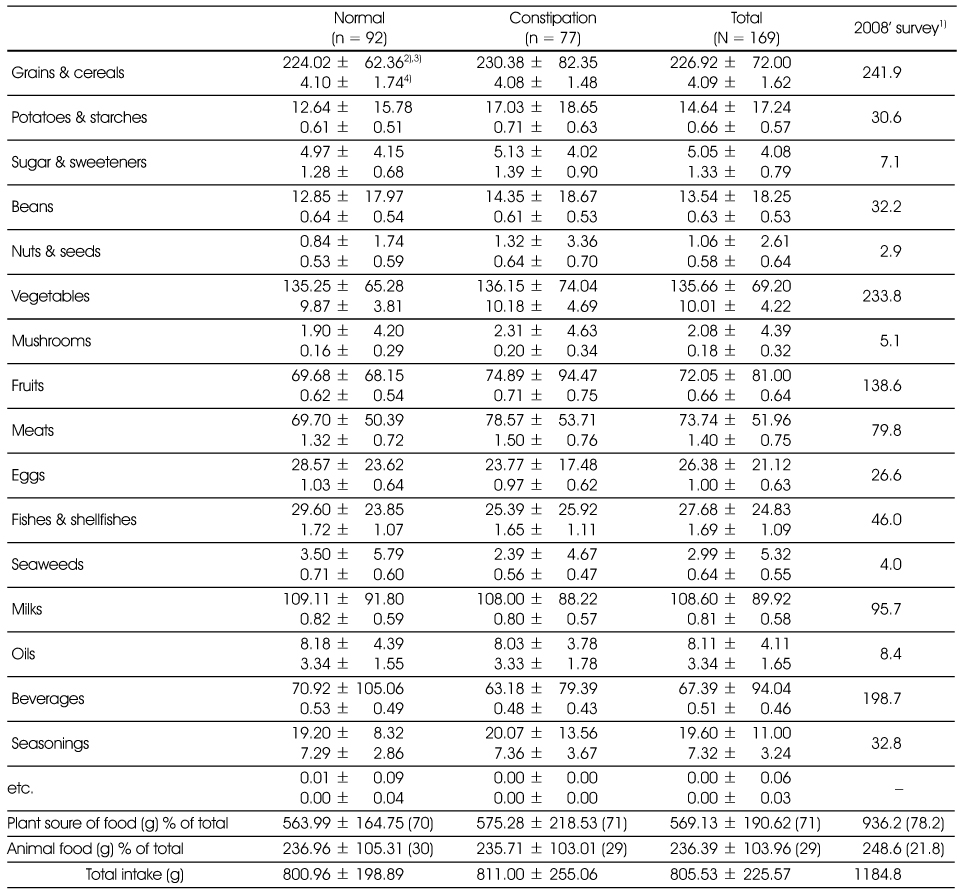References
1. Bae YJ, Lee JC, Kim MH. Nutritional status and dietary quality of college students by residing types in Samcheok. J Korean Diet Assoc 2007. 13(4)311–330.
2. Byeon YS. The dietary habits and elimination of university woman. Nurs Sci 2002. 14(1)18–25.
3. Choi H, Choi MG, Kim SW, Moon SB, Kim BK, Kim BW, Kim JK, Han SW, Choi KY, Chung IS, Chung KW, Sun HS. Functional gastrointestinal disorders in patients with gastrointestinal symptoms. Korean J Gastroenterol 1999. 33741–748.
4. Choi JH, Kim SK. Comparison of the dietary factors between normal and osteopenia groups by bone mineral density in Korean female college students. J Korean Soc Food Sci Nutr 2008. 37(7)869–878.
5. Choi JS, Paik HY. Seasonal variation of nutritional intake and quality in adults in longevity areas. J Korean Soc Food Sci Nutr 2004. 33(4)668–678.
6. Choi MG. Evidence based guideline for diagnosis and treatment : Diagnostic guideline for constipation. Korean J Neurogastroenterol Motil 2005. 11(3)44–50.
7. Cheon LY, Ho KY, Phua KH. Noraml bowl habits and prevalence of functional bowel disorders in Singaporean adultsfindings from a community based study in Bishan. Singapore Med J 2000. 41255–258.
8. Cheong SH, Kwon WJ, Chang KJ. A comparative study on the dietary attitudes, dietary behaviors and diet qualities of food and nutrition major and non-major female university students. Korean J Community Nutr 2002. 7(3)293–303.
9. Chung HJ, Park HW, Choi EJ, Lee JJ. A study of the lifestyle factors related to constipation among food habits of college students in Seoul and Gyunggi. Korean J Community Nutr 2002. 7(5)654–663.
10. Drossman DA. The functional gastrointestinal disorders and the Rome III process. Gastroenterology 2006. 1301377–1390.
11. Hong JY. Diet theraphy for constipation. Industrial Health 2004. 19554–60.
12. Irvine EJ, Ferrazzi S, Pare P. Health-related quality of life in functional GI disorders; Focus on constipation and resource utilization. Am J Gastroenterol 2002. 971986–1993.
13. Jun DW, Park HY, Lee OY, Lee HL, Yoon BC, Choi HS, Hahm JS, Lee MH, Lee DH, Kee CS. A population-based study on bowel habits in a Korean community: prevalence of functional constipation and self-reported constipation. Dig Dis Sci 2006. 51(8)1471–1477.
14. Kang HJ, Byun KW. Effect of two-year course of food and nutrition on improving nutrition knowledge, dietary attitudes and food habits of junior college feamle students. Korean J Community Nutr 2010. 15(6)750–759.
15. Kim SH. A survey on dietary behaviors and liquid consumptions of university students in Kongju of Chungnam province in Korea. Korean J Nutr 2009. 42(4)327–337.
16. Lee KA, Kim HJ, Yoon HS. Constipation prevalance and lifestyle factors affecting constipation of high school students in Gimhae area. J Korean Diet Assoc 2009. 15(4)419–432.
17. Lee RD, Nieman DC. Nutritional assessment 2007. 4th edth ed. New York: McGraw-Hill International ed;
18. Lim ET, Kim YN. The relationship between the prevalence of constipation and beverage intake of female high school students in Seoul. Korean J Community Nutr 2003. 8(6)856–866.
19. Lim YJ, Choi YS. Dietary behaviors and seasonal diversity of food intakes of elderly women living alone as compared to those living with family in Gyeongbuk rural area. Korean J Community Nutr 2008. 13(5)620–629.
20. Myung SJ, Lee TH, Huh CH, Choi SC, Sohn CI. Diagnosis of constipation; a systematic review. Korean J Gastroenterol 2010. 55316–324.
21. Na HJ, Kim YN. The prevalence of constipation and dietary fiber intake of 3rd grade high school girls. Korean J Nutr 2000. 33(6)675–683.
22. Shemerovkiĭ KA. Constipation-a risk factor for colorectal cancer. Klin Med (Mosk) 2005. 83(12)60–64.
23. Shin JR, Ly SY. Dietary habits and factors related to lifestyles in constipated female students. Korean J Community Nutr 2003. 8(5)675–688.
24. Song YJ, Paik HY. Seasonal variation of dietary intake and quality from 24 hour recall survey in adults living in Yeonchon area. J Korean Soc Food Nutr 1988. 27(4)775–784.
25. Statics Korea. Cause of death statics, 2009 2010.
26. Teitelbaum JE, Sinha P, Micale M, Yeung S, Jaeger J. Obesity is related to multiple functional abdominal diseases. J Pediatr 2009. 154(3)444–446.
27. Thompson WG, Longstrech GF, Drossman DA, Heaton KW, Irvine EJ, Muller-Lissner SA. Functional bowel disorders and functional abdominal pain. Gut 1999. 45Suppl 2. II43–II47.
28. The Korea Center for Disease Control and Prevention. National health & nutrition survey, 2008 2009.
29. The Korean Nutrition Society. Dietary reference intakes for Koreans 2010. 1st revisionth ed.
30. Yang HG. Knowledge of the anus disease 1999. Seoul: Yangbangwon press; 193.
31. You JS, Chin JH, Kim MJ, Chang KJ. College students' dietary behaviors, health-related lifestyles and nutrient intake status by physical activity levels using international physical activity questionnaire (IPAQ) in Incheon area. Korean J Nutr 2008. 41(8)818–831.
32. You JS, Chin JH, Chang KJ. Prevalence of constipation, bowl habits and nutrient intakes of college students in Incheon area. Korean J Nutr 2009. 42(8)702–713.
33. Watanabe T, Nakaya N, Kurashima K, Kuriyama S, Tsubono Y, Tsuji I. Costipation, laxative ues and risk of colorectal cancer : The miyagi cohort study. Eur J Cancer 2004. 40(14)2109–2115.
34. Wei X, Chen M, Wang J. The epidemiology of irritable bowel syndrome and functional constipation of Guangzhou residents. Zhonghua Nei Ke Za Zhi 2001. 40517–520.







